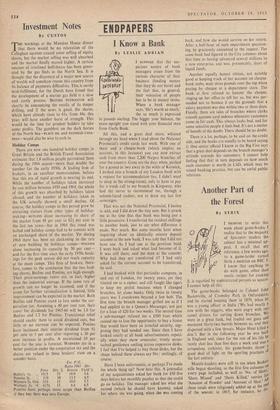Another Part of
the Forest
By STRIX
The game-books belonged to Colonel John Baskerville, of Crowsley Park in Oxfordshire, and he started keeping them in 1859, when he was a young officer in India (`We had nearly 3 row with the niggers, who were angry with our camel drivers for cutting down branches. We, were in a great funk, but loaded our guns and mustered thirty-two barrels between us, and they dispersed with a few threats. Major Hunt killed a doe.'). But in the following year he was back in England and, since for the rest of his life he rarely shot less than five days a week and was a scrupulous archivist, his game-books throw good deal of light on the sporting practices el the last century.
Muzzle-loaders were still in use when Basket ville began shooting, so the first five columns on every page included, as well as `No. of Shots, `Shots Missed' and `Shots Killed,' entries be,r, `Amount of Powder' and 'Amount of Shot.' AIAI these totals were religiously added up at the en of the season; in 1865, for instance, he d'5'
charged 2 cwt. 46 lb. 31 oz. of shot with the aid of 46 lb. 2 oz. and # of a dram of powder, missing 1,480 chances out of 3,623. But in the decade that followed, first the breech-loader and then the ready-made cartridge came in, and the statistician's burden was lightened. After 1886 (when he fired 8,928 shots and killed with 5,467 of them) he gave up counting the cartridges.
By then Baskerville was well on into his second game-book, and the alterations in its layout reflect a change in shooting practices, and in people's attitude towards the sport. The left-hand page was still devoted to 'Game Killed by Self' and the right-hand page to 'Game Killed by Party,' but the cult of the individual was on the decline; 'Highest Bag made by' had, like the drams and the hundredweights, been dropped. From being Peter Hawker-type forays with a
slightly competitive flavour (`Mr. Young shot very badly'), shooting days were becoming more highly organised, more urbane and-on the whole more fruitful. The 1880 season's total of some
2,500 pheasants had more than doubled by the 1890s.
There are several surprising things about the ',hooting-field of those days, of which Basker- One's experiences were so wide that they must have been reasonably representative. One is the low standard of retrieving, attested by the con- Aant references to wounded birds being lost. They used setters or pointers for grouse and partridges, and spaniels to hunt out the rabbits which at the end of the year were always the biggest item in the bag; but they never seemed to have a dog that could find a runner, and they must have wasted many hours and suffered much disappointment from this cause.
Hares, of which there were clearly a great many, were held in unexpected veneration; there are many references ('two hares shot by mistake') to days on which the host had decreed that none were to be killed. In striking contrast is the prac- • tiee, which seems to have been well established ikt the 1890s, of having a full-scale day at the 'Partridges in the last week of January. By then, in a normal year, the birds have paired, and even if they had not jt would seem the height of -folly to make an all-out attack on your br6eding-stock on the eve of the close season. It 'was done so regularly that one feels there must have been some theory behind it,
11 I
One thing that has not changed at all is the disastrous consequences to game of a wet sum- mer. In January 1880 Baskerville recorded 'the end of probably the worse game season ever known. Partridges almost exterminated every- iNhere, and wild pheasants as bad. In many parts of the country even the rabbits have been de- stroyed by the constant rain up to September.' One takes comfort from the fact that exactly two Years later he was writing, 'End of a first-rate game season, the best I ever saw, and plenty of stock left.'
' The Baskervilles no longer live at Crowsley; the 'ferns' in the park (bracken seems to have been,itt neologism not yet current in the last century) are picketed by the masts of the BBC's monitoring service. Nor are the Stapletons still
Ant possession of Greys Court, an adjacent estate. "tut both families were going strong when Conan Doyle wrote The Hound of the Baskervilles, and I have often wondered whether Oxfordshire read more than the author intended into the fact that the villain of the piece, the all too successful Persecutor of the Baskerville family, was called Stapleton.







































 Previous page
Previous page